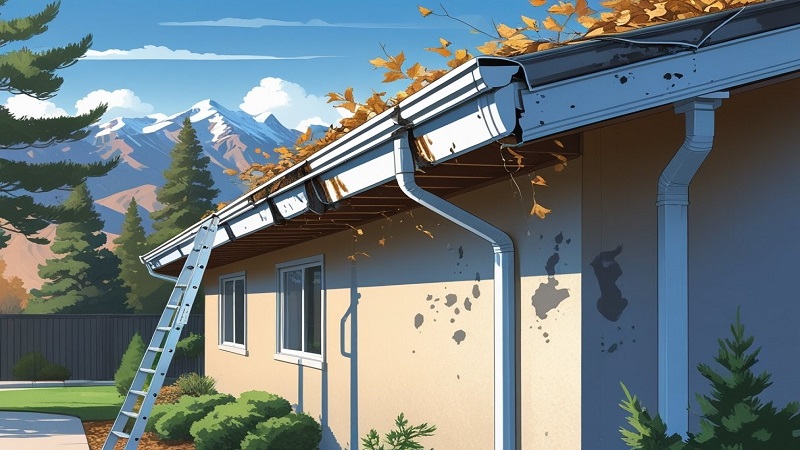Your home’s gutters work constantly to protect your property from water damage by directing rainwater away from your foundation and exterior walls. In Denver’s unpredictable weather conditions, where sudden storms and heavy rainfall are common, a functioning gutter system becomes even more critical for maintaining your home’s structural integrity.
Most gutters can last over 20 years with proper maintenance, but neglect or damage can significantly shorten their lifespan and put your home at risk. Homeowners who ignore early warning signs often face costly repairs that could have been prevented with timely gutter replacement.
Recognizing the key indicators that your gutters need replacement allows you to take proactive steps before minor issues become major problems. Understanding these warning signs, along with knowing when to seek professional help, can save homeowners thousands of dollars in potential water damage repairs.
Top Signs You Need Gutter Replacement in Your Denver Home
Damaged gutters can lead to serious water damage around your home’s foundation, siding, and roof. Several key indicators help homeowners determine when to replace gutters rather than simply repair them.
Sagging or Pulling Gutters
Sagging gutters represent one of the most obvious signs that gutter replacement is necessary. When gutters begin to pull away from the house or sag in the middle, they can no longer effectively channel water away from the home.
This problem typically develops when gutters become too heavy from debris accumulation or when the fastening system weakens over time. Sagging gutters often indicate that the gutter system has reached the end of its useful life.
Denver’s weather conditions can accelerate this deterioration. Heavy snow loads during winter months put additional stress on gutter systems, causing them to bend or separate from mounting brackets.
Homeowners should examine their gutters from ground level regularly. Visible gaps between the gutter and the house or noticeable dips in the gutter line signal immediate attention is needed. Water pooling in sagged sections creates breeding grounds for mosquitoes and can cause additional structural damage.
Cracks, Holes, and Rust
Small cracks and holes in gutters may seem minor, but they often expand rapidly and compromise the entire system’s effectiveness. Rust formation on metal gutters indicates ongoing corrosion that will continue to worsen without intervention.
Multiple small holes or cracks throughout the gutter system suggest widespread deterioration. While individual holes might be patched temporarily, extensive damage requires complete gutter replacement to ensure proper water management.
Denver’s temperature fluctuations contribute to crack development. The freeze-thaw cycle causes metal to expand and contract repeatedly, creating stress fractures that grow over time.
Rust stains on gutters or surrounding areas indicate metal deterioration. Once rust penetrates the gutter material, it spreads quickly and weakens the structural integrity of the entire system.
Peeling Paint and Rust Stains
Paint peeling from gutters or rust stains on the home’s exterior walls indicate water is escaping from the gutter system. These visual signs often appear before homeowners notice other gutter problems.
Rust stains on siding or foundation walls show that water has been overflowing or leaking from gutters for an extended period. This constant moisture exposure can lead to more serious structural issues if left unaddressed.
Peeling paint on gutters themselves suggests the protective coating has failed. Without proper paint protection, metal gutters deteriorate rapidly, especially in Denver’s variable climate conditions.
Water stains on the home’s exterior walls directly below gutters indicate overflow or leakage problems. These stains often appear as dark streaks or discoloration on siding materials.
Overflowing or Constantly Clogged Gutters
Gutters that overflow during moderate rainfall or require frequent cleaning may have structural problems beyond simple debris accumulation. Constantly clogged gutters can indicate improper slope, damaged sections, or worn-out gutter guards.
When gutters cannot handle normal water flow, they fail to protect the home from water damage. Overflow water can pool around the foundation, creating basement flooding risks and soil erosion problems.
Gutters should drain completely within hours after rainfall ends. Standing water in gutters suggests improper installation, damage, or significant wear that prevents proper water flow.
Frequent clogs despite regular maintenance may indicate that the gutter system no longer functions effectively. This problem often develops when gutters have shifted position or developed internal damage that traps debris.
Prevention and Next Steps After Noticing Gutter Issues
Taking immediate action when gutter problems arise prevents costly water damage and structural issues. Regular maintenance schedules and professional installation of quality components create long-term protection for Denver homes.
Importance of Gutter Maintenance
Regular gutter maintenance prevents minor issues from becoming major problems that require complete replacement. Denver homeowners should inspect their gutters twice yearly, particularly after spring snowmelt and before winter weather arrives.
Essential maintenance tasks include:
- Cleaning debris from gutters and downspouts monthly
- Checking for loose brackets and hardware
- Examining seams for separation or leaks
- Testing water flow during rainstorms
Gutter maintenance tips focus on clearing blockages that cause water overflow. Leaves, twigs, and granules from asphalt shingles commonly accumulate in Denver gutters.
Professional maintenance services identify problems early through detailed inspections. They spot issues like improper slope, damaged fascia boards, or inadequate drainage that homeowners might miss.
Scheduled maintenance costs significantly less than emergency repairs or full replacement. Property owners who maintain their gutters properly extend system lifespan by 5-10 years.
Benefits of New Gutters and Proper Installation
New gutters provide superior water management compared to patched or aging systems. Modern materials resist Denver’s freeze-thaw cycles and UV damage more effectively than older installations.
Professional gutter installation ensures proper sizing and placement for optimal performance. Contractors calculate appropriate gutter capacity based on roof area and local rainfall patterns.
Key installation benefits include:
- Seamless construction that eliminates leak-prone joints
- Proper slope calculation for efficient drainage
- Secure mounting that withstands wind and snow loads
- Coordinated downspout placement for effective water disposal
Quality installation prevents common problems like sagging, overflow, and foundation damage. Professional contractors understand local building codes and weather challenges specific to Denver’s climate.
New gutters increase property value while reducing maintenance requirements. Modern systems require less frequent cleaning and repairs compared to older installations.
Choosing Gutter Guards and Accessories
Gutter guards reduce maintenance frequency by preventing debris accumulation while allowing water flow. Denver homeowners benefit from guards that handle heavy snow loads and ice formation.
Popular guard types include:
Guard Type | Benefits | Best For |
Mesh screens | Blocks leaves and large debris | Homes with deciduous trees |
Solid covers | Prevents all debris entry | Low-maintenance preference |
Foam inserts | Easy installation and removal | DIY-friendly option |
Gutter guards work most effectively on properly functioning systems. Installing guards on damaged gutters wastes money and creates false security about system performance.
Additional accessories enhance gutter performance in Denver’s climate. Heating cables prevent ice dams, while splash blocks direct water away from foundations.
Professional installation ensures gutter guards fit securely without creating drainage problems. Improper installation can trap debris or reduce water flow capacity during heavy storms.

















